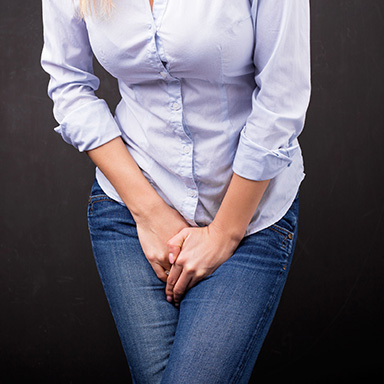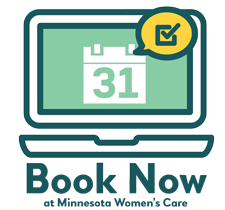Discover effective ways to manage incontinence ... without surgery.
A lot of women are looking for ways to manage urinary incontinence – the involuntary loss of urine. It is a common problem for women, but that doesn’t mean it is normal or that you have to live with incontinence.
 Stress Incontinence and Urge Incontinence
Stress Incontinence and Urge Incontinence
There are two main types of incontinence: stress incontinence and urge incontinence – and some women have both.
About Stress Incontinence
Stress Incontinence is loss of urine associated with activity or physical exertion such as coughing, sneezing, laughing, or exercising. This type of leakage mainly results from loss of support for the urethra. I like to think about this as a pressure problem. When the pressure you generate in the abdomen (where the bladder sits) with activity such as coughing is more than the pressure the urethra can hold in – you leak. One of the main factors contributing to some loss of support (ie weakness) of the urethra that may be related to childbirth. Other factors that can contribute is obesity, chronic straining or heavy lifting may further worsen support for the urethra.
While there are surgical options to manage incontinence, the good news are effective non-surgical options as well. Non-surgical options to manage stress incontinence include:
- Weight loss. Women who are overweight or obese (ie BMI >25) and who can lose 8% of their body weight (ie: 16 lbs for a 200lb woman) have over a 40% reduction in leakage episodes. If there is any motivation for weight loss let it be this. However, losing weight is not easy and you may benefit from a care team to help you with your weight loss goals. Talk with us. We can help.
- Pelvic floor therapy. Yes, you may have heard it before but doing your kegels can help. Kegels or pelvic floor muscles exercises strengthen the muscles that support the urethra and can reduce stress incontinence. It is important to ensure you are exercising the correct muscles. These are the muscles you squeeze when you are trying to hold in urine or gas. You want to exercise them by doing short and long squeezes (up to 10 seconds) a few times a day most days of the week. As with any muscle, without regular exercise these muscles can weaken.
If you have been trying kegels on your own without success it may be because you are not identifying or isolating the right muscles and you may benefit from biofeedback – a fancy way to say someone or something helping you identify and isolate the correct muscles. Having evaluation with a pelvic floor therapy provider may help you to have a better outcome with pelvic floor exercises to manage your incontinence if you have tried and not been successful on your own. We offer physical therapy with and without biofeedback at MNWC. There are also a subset of women with pelvic floor muscle spasms that doing kegels may worsen pelvic pain. We recommend being evaluated before starting pelvic floor exercises if you have pelvic pain. Again, talk to us. We can help - Vaginal insert devices. A vaginal insert device is a support device that sits in the vagina to help support the urethra giving the urethra the extra pressure it needs to counter the pressure of the cough to prevent leakage. There are over the counter devices as well as a medical devices you are fitted for called a pessary. The vaginal insert device should not prevent you from being able to urinate normally. Some of the downsides of the device are some maintenance is required. Also, the over the counter devices tend to be more uncomfortable especially for menopausal patients and cannot be reused.
- Vaginal laser therapy. While the effectiveness of vaginal laser therapy for managing stress incontinence is still being evaluated, there is some good news about this being another effective management option. There is currently an ongoing study enrolling new patients interested in helping evaluate the effectiveness of the laser for stress incontinence. If you are interested in participating in this study or want more information about this you can reach out to our clinic. Click to read about the PURSUIT Study.
About Urge Incontinence
Urge Incontinence is loss of urine related to an urge to urinate that cannot be deferred. Women with urge incontinence often feel they go to the bathroom too often and have a very strong sudden urge to urinate. Many women also have a “key in door” phenomenon where as soon as you know you are close to the bathroom it just starts coming out. Urge incontinence is primarily from a bladder sensation problem where the bladder senses urine at too little volume or does not get the brain enough time to respond to the sense of urge before the bladder spasms/contracts and urine leaks.
Non-surgical options to manage urge urinary incontinence include:
- Lifestyle modifications and fluid management.
I see a lot of women who are overdrinking because there is so much information in the media about drinking your weight in water or drinking a gallon of water a day to manage weight etc. While staying hydrated is important, if you are bothered by urge incontinence and overactive bladder it can be helpful to record what you are drinking. If you are drinking more than 1.5-2L of fluid per day you may benefit from decreasing your fluids.
What you are drinking also matters. Caffeine, soda, tea, and carbonated beverages can all be bladder irritants that can worsen the urge and urge leakage. Plain water or herbal teas are the best for the bladder.
Losing weight can also help urge incontinence - Bladder retraining and timed voiding can be helpful. Sometimes you wait too long and scheduling trips to the bathroom can help prevent leakage. Bladder retraining involves pelvic floor therapy to make the pelvic floor muscles strong, then you can squeeze the muscles when the urge comes on. This should stop the urge and once the urge is gone then make your way to the bathroom. Bladder retraining can also help with bothersome urinary frequency as well. Working with pelvic floor therapy can be helpful to help ensure you are doing the correct exercises to make your efforts the most successful.
- Medications. Medications can be helpful to manage urge incontinence symptoms. Medications work to help the bladder hold more and prevent strong urges and urge leakage.
